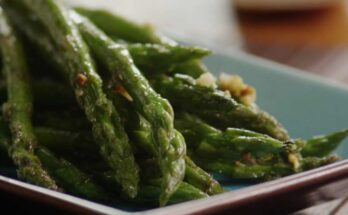Romanesco Recipe: Ever laid eyes on a vegetable that looks like it came straight out of a sci-fi movie? That’s Romanesco for you. This vibrant, chartreuse-colored veggie is a member of the Brassica family—cousin to cauliflower, broccoli, and cabbage. Its most striking feature? The mesmerizing fractal pattern of its florets. Each bud is a smaller version of the whole head, spiraling out in perfect mathematical precision. But don’t let its otherworldly appearance intimidate you—Romanesco is not just beautiful, it’s also absolutely delicious.
Romanesco’s texture falls somewhere between cauliflower and broccoli—slightly nutty, a bit sweet, and wonderfully crisp when cooked right. And the best part? It’s incredibly versatile. Whether you’re roasting, steaming, sautéing, or tossing it into pasta, Romanesco can hold its own in nearly any dish. It adds not only flavor but a serious dose of visual appeal.
If you’re someone who loves experimenting in the kitchen or just wants to impress guests with something that looks gourmet but is easy to cook, this Romanesco recipe will be your new go-to. Let’s dive into why this vegetable deserves a permanent spot in your kitchen.
Why Cook Romanesco?
Sure, it’s pretty, but Romanesco’s appeal goes way beyond looks. One of the main reasons to cook Romanesco is its mild yet distinctive flavor. It’s less bitter than broccoli and more flavorful than cauliflower, making it a crowd-pleaser even for picky eaters. If you’ve been struggling to get the kids—or even adults—to eat more vegetables, this might just be your secret weapon.
Cooking Romanesco also allows you to explore different textures. Roasted Romanesco becomes crispy on the edges while staying tender inside. Steam it, and you get a soft, comforting bite. Sauté it quickly for something in-between. It works great in curries, pasta dishes, stir-fries, and even grain bowls.
Plus, it’s packed with health benefits (we’ll get to that next), and it’s seasonal—usually available in the fall and winter—making it a great option for cozy, hearty meals during colder months. And let’s not forget, cooking with unique veggies like Romanesco makes home cooking exciting again. It’s one of those ingredients that gets people asking, “What is that?”—and we all love serving dishes that come with a little bit of mystery and wow factor.
Health Benefits of Romanesco
Nutritional Value
Romanesco isn’t just easy on the eyes and the palate—it’s a nutritional powerhouse too. One serving of Romanesco (about one cup cooked) provides roughly:
- 25–30 calories
- 2 grams of protein
- 5 grams of carbohydrates
- 3 grams of dietary fiber
- 0 grams of fat
That means it’s low in calories and carbs, high in fiber, and keto- or weight-loss-friendly. It’s also rich in antioxidants, particularly carotenoids and flavonoids, which help protect the body from oxidative stress and inflammation.
Romanesco contains sulforaphane, a compound also found in broccoli and other cruciferous veggies, known for its cancer-fighting properties. So if you’re looking to eat healthier without compromising on taste, Romanesco is an excellent choice.
Vitamins and Minerals
Romanesco delivers a serious vitamin and mineral punch. It’s especially high in:
- Vitamin C: Boosts your immune system and promotes skin health.
- Vitamin K: Essential for blood clotting and bone health.
- Folate (Vitamin B9): Important for brain function and prenatal health.
- Potassium: Regulates fluid balance and helps maintain healthy blood pressure.
- Fiber: Aids digestion and keeps you full longer.
It’s rare to find a food that’s this nutrient-dense and also so delicious. Incorporating Romanesco into your meals is an easy way to add more vitamins and minerals to your diet without relying on supplements.
Health-Boosting Properties
Let’s break it down. Romanesco can:
- Improve digestion: Thanks to its high fiber content.
- Boost your immune system: With all that vitamin C.
- Support heart health: With potassium and anti-inflammatory antioxidants.
- Aid in detoxification: Sulforaphane helps eliminate toxins from the body.
- Enhance brain function: Folate is essential for cognitive development and mood regulation.
Adding Romanesco to your diet is like pressing the “upgrade” button on your health—without needing a drastic lifestyle change. It’s a small step with big rewards, especially when it tastes this good.
Choosing the Right Romanesco
How to Pick Fresh Romanesco
The first step to making an unforgettable Romanesco dish is choosing the freshest head available. When you’re at the farmer’s market or grocery store, look for these signs:
- Bright green or chartreuse color: Dull or yellowing Romanesco is past its prime.
- Tightly packed florets: The fractals should be firm and compact.
- No brown spots or blemishes: This indicates freshness.
- Firm texture: It should feel solid and heavy for its size, not soft or spongy.
- Fresh smell: There shouldn’t be any sour or unpleasant odor.
If you can, buy organic Romanesco. It’s usually grown with fewer pesticides, and since Romanesco is often eaten with minimal seasoning, purity matters.
Where to Buy It
Romanesco isn’t as common as broccoli or cauliflower, but it’s becoming more widely available. Look for it at:
- Farmers’ Markets: Often the freshest and most flavorful.
- Specialty Grocery Stores: Like Whole Foods, Trader Joe’s, or Sprouts.
- Online Produce Boxes: Some services deliver seasonal produce to your door.
- Local Co-ops: Community-supported agriculture (CSA) boxes sometimes include Romanesco in the fall and winter.
Timing matters too. Romanesco is typically in season from October through February, so that’s your best window for peak quality and taste.
Ingredients You’ll Need
Main Ingredients
Ready to cook? First, let’s make sure you have everything on hand. Here are the core ingredients for a classic roasted Romanesco recipe:
- 1 medium head of Romanesco
- 2 tablespoons olive oil
- 2 cloves garlic (minced)
- 1 teaspoon sea salt
- ½ teaspoon black pepper
- Juice of half a lemon
- Zest of one lemon (optional)
These ingredients strike the perfect balance—olive oil for richness, garlic for depth, salt and pepper for punch, and lemon for brightness. It’s a simple combo, but trust us—it delivers.
Optional Add-ins for Extra Flavor
Want to elevate your Romanesco game? Here are a few flavorful upgrades:
- Red pepper flakes – for a spicy kick
- Grated Parmesan cheese – adds umami and richness
- Fresh herbs – like thyme, parsley, or rosemary
- Toasted pine nuts or slivered almonds – for a crunchy contrast
- Balsamic glaze – drizzle after roasting for a sweet-tangy finish
- Paprika or cumin – for earthy depth
You can mix and match based on your mood or what’s in your pantry. That’s the beauty of Romanesco—it plays well with a wide range of flavors.
Tools and Equipment Required
Basic Kitchen Tools
Before you begin crafting your Romanesco masterpiece, it’s important to gather the right kitchen tools. Having the right equipment not only saves time but ensures that each step is executed smoothly. Here’s what you’ll need for this recipe:
- Cutting board: Preferably a large, non-slip one for chopping Romanesco easily.
- Sharp chef’s knife: To slice through the thick stem and break the head into florets.
- Large mixing bowl: For tossing the florets with oil and seasoning.
- Baking sheet: A flat, sturdy tray for roasting. Go with rimmed edges to avoid spills.
- Parchment paper or silicone mat: Keeps things from sticking and makes cleanup a breeze.
- Tongs or spatula: For flipping and stirring during roasting.
- Measuring spoons: For precise seasoning.
These basics are probably already in your kitchen, and they’ll make the process seamless from start to finish. No fancy tools required—just good, solid essentials.
Helpful Cooking Gadgets
If you want to go the extra mile and make your life even easier, here are a few gadgets that can help:
- Garlic press: Speeds up the garlic mincing process.
- Citrus zester: Perfect for adding fresh lemon zest with minimal effort.
- Vegetable steamer: If you decide to steam instead of roast your Romanesco.
- Food processor: If you’re planning to puree it into a sauce or soup.
Again, not mandatory, but these tools can enhance the experience and save time, especially if you’re prepping for a crowd or batch cooking for the week.
Step-by-Step Guide to Making Romanesco
Step 1: Wash and Cut Romanesco
Start by rinsing the Romanesco under cool running water to remove any dirt or debris hidden between its fractal florets. Trim the outer leaves and cut the Romanesco into evenly sized florets, just like you would with broccoli or cauliflower. Uniform pieces ensure even cooking and that signature tender-yet-crispy texture.
Step 2: Blanching for Texture
Bring a large pot of salted water to a boil. Add the Romanesco florets and blanch for 2–3 minutes, just until they turn bright green and slightly tender. Quickly transfer them to an ice bath to stop the cooking process and lock in their color and crunch. Drain well before the next step.
Step 3: Seasoning and Preparation
In a large mixing bowl, toss the blanched florets with olive oil, salt, and black pepper. For added flavor, you can sprinkle garlic powder, lemon zest, or Parmesan cheese. The seasoning should coat each floret evenly for balanced taste and a golden finish when roasted.
Step 4: Roasting to Perfection
Preheat your oven to 425°F (220°C). Spread the Romanesco florets in a single layer on a baking sheet lined with parchment paper. Roast for 20–25 minutes, shaking the pan halfway through, until the edges are golden brown and slightly crispy. The high heat brings out a nutty, caramelized flavor that makes Romanesco irresistible.
Step 5: Final Touches and Plating
Once roasted, transfer the Romanesco to a serving dish. Drizzle with a squeeze of fresh lemon juice or a touch of balsamic glaze for brightness. Garnish with chopped herbs like parsley or a sprinkle of red pepper flakes if you want a little heat.
Serve warm as a side dish or toss it into grain bowls, pastas, or salads — Romanesco’s stunning look and mild, nutty taste make it the showstopper of any plate.
Romanesco Recipe Variations
Roasted Romanesco with Garlic and Lemon
This is the classic Romanesco dish that turns even the most skeptical veggie-eaters into fans. Roasted Romanesco with garlic and lemon is all about simplicity and flavor. It’s easy to make and pairs beautifully with almost any main course—be it grilled chicken, salmon, or a plant-based protein.
To make this variation:
- Preheat the oven to 425°F (220°C).
- Toss the Romanesco florets in olive oil, minced garlic, salt, pepper, and the juice of half a lemon.
- Spread out on a baking sheet and roast for 25 minutes, turning once halfway.
- Sprinkle lemon zest and a pinch of red pepper flakes before serving.
The result? A crispy, golden brown outside with a tender center and zesty brightness in every bite. It’s a dish that looks elegant, tastes amazing, and takes less than 40 minutes from prep to plate.
Romanesco Pasta Dish
Want something heartier? Toss your roasted Romanesco into a creamy pasta, and you’ve got yourself a full-blown meal. Romanesco works wonderfully with al dente pasta and adds both texture and nutrition to any bowl.
Here’s a quick Romanesco pasta idea:
- Cook your pasta (penne, rigatoni, or fusilli work great) until al dente.
- Roast Romanesco with olive oil, garlic, and lemon as described earlier.
- Make a light sauce by sautéing garlic in olive oil or butter, then add a splash of pasta water and grated Parmesan or nutritional yeast.
- Toss everything together, sprinkle with herbs, and top with extra cheese or chili flakes.
This dish is comforting, satisfying, and surprisingly light. Add a handful of toasted breadcrumbs for extra crunch and you’re golden.
Romanesco Stir-Fry
Looking for something fast and healthy? A Romanesco stir-fry is a quick weeknight winner. It keeps the veggie crisp and brings out its earthy notes, especially when cooked with bold Asian flavors.
To make it:
- Blanch the Romanesco for 2–3 minutes to keep it tender-crisp.
- Stir-fry in sesame oil with garlic, ginger, and green onions.
- Add soy sauce, a touch of honey or maple syrup, and chili flakes or Sriracha.
- Toss in sesame seeds and serve over jasmine rice or noodles.
This is the perfect option if you want something low-effort but high-reward. Bonus? It’s easily customizable—throw in tofu, mushrooms, or bell peppers for a veggie-packed feast.
Tips for the Perfect Romanesco Dish
Cooking Do’s and Don’ts
Making Romanesco isn’t difficult, but there are a few pro tips that can take your dish from good to great.
Do:
- Use high heat when roasting for maximum caramelization.
- Keep the florets evenly sized for consistent cooking.
- Blanch before roasting or sautéing if you prefer a softer texture.
- Season well! Romanesco can handle bold flavors.
- Add acidity (lemon, vinegar) to enhance its natural nuttiness.
Don’t:
- Overcrowd the pan. This causes steaming instead of roasting.
- Overcook—it turns mushy fast and loses its vibrant green color.
- Skip the oil. A light coating helps it crisp up and carry flavors.
- Forget to dry it after washing or blanching. Wet veggies steam instead of roast.
Cooking Romanesco is a balance of technique and timing. Stick to these basic rules, and you’ll be golden every time.
Common Mistakes to Avoid
Even seasoned cooks can mess up a Romanesco dish. Here are some common pitfalls and how to avoid them:
- Cutting florets too large or unevenly: They’ll cook at different rates, leading to some undercooked or burnt pieces.
- Using too little oil: This leads to dry, bland veggies.
- Not preheating the oven: Always get your oven up to temp before roasting.
- Skipping the flip: Stir or flip your Romanesco halfway through roasting to ensure even browning.
- Forgetting seasoning: A good veggie dish needs more than just salt—don’t be afraid to experiment with spices, herbs, and acidity.
Avoid these traps, and you’ll find Romanesco to be one of the most rewarding vegetables to cook with. It’s forgiving, flavorful, and incredibly versatile.
Serving Suggestions
Side Dishes that Pair Well
Romanesco is great on its own but truly shines when paired with complementary sides. Here are a few serving ideas to round out your meal:
- Grilled proteins: Like chicken breast, salmon fillets, or steak.
- Whole grains: Quinoa, couscous, or farro provide a nice nutty contrast.
- Creamy mashed potatoes or polenta for a soft, comforting base.
- A simple garden salad with vinaigrette to cut through the richness.
- Hummus or tahini sauce: These Middle Eastern dips pair beautifully with roasted Romanesco.
The mild, slightly nutty taste of Romanesco means it plays nicely with a wide range of cuisines—from Italian and Mediterranean to Asian-inspired dishes.
Presentation Ideas
Don’t underestimate the power of a good presentation. Romanesco’s natural fractal design is visually stunning, so let it shine:
- Serve on a white or black plate to make the green pop.
- Garnish with herbs or edible flowers for a touch of elegance.
- Layer with roasted carrots or beets for colorful contrast.
- Add a drizzle of sauce (think balsamic glaze or yogurt tahini) in a zigzag pattern for a chef-like touch.
Whether you’re serving family-style or plating individually, presentation adds that final wow factor. And honestly, Romanesco kind of does all the work for you—it’s just that photogenic.
Storing and Reheating Romanesco
Best Storage Methods
After putting in the effort to cook up a delicious Romanesco dish, the last thing you want is for leftovers to go to waste. Luckily, Romanesco stores quite well when handled properly. Here’s how to keep it fresh:
- Refrigerator Storage: Place cooked Romanesco in an airtight container and store it in the fridge. It will stay good for up to 4 days. Make sure the container is sealed tightly to prevent the florets from drying out or absorbing odors from other foods.
- Raw Storage: If you’ve got leftover uncooked Romanesco, wrap it loosely in a paper towel and place it inside a perforated plastic bag or vegetable crisper drawer. It should last up to a week when stored this way.
- Avoid Moisture Buildup: Whether cooked or raw, Romanesco doesn’t do well with excess moisture. Always let it cool completely before sealing and refrigerating, and consider lining your container with a paper towel to absorb extra humidity.
- No Freezing for Raw Romanesco: Freezing uncooked Romanesco can ruin its texture. If you want to freeze it, blanch it first.
How to Reheat Without Losing Flavor
Reheating Romanesco the right way ensures it stays tasty and doesn’t become a mushy mess. Here are the best techniques:
Oven Method (Best for Roasted):
- Preheat your oven to 375°F (190°C).
- Spread Romanesco on a baking sheet in a single layer.
- Heat for about 10 minutes, or until warmed through and slightly crisp again.
Stovetop Method:
- Add a small amount of oil to a non-stick pan.
- Heat over medium heat, stirring occasionally for about 5–7 minutes.
Microwave Method (Quickest but Least Ideal):
- Place in a microwave-safe bowl.
- Cover with a damp paper towel.
- Microwave in 30-second intervals until warm. Be cautious—this can make it soft and soggy.
To bring back that fresh flavor, squeeze a bit of lemon juice or sprinkle with fresh herbs after reheating. It’ll perk it right back up!
FAQs about Romanesco Recipe
Can you eat Romanesco raw?
Yes! Romanesco can be eaten raw and makes a great addition to salads or crudité platters. Its crisp texture and mild, nutty flavor shine when dipped in hummus or drizzled with a vinaigrette. Just make sure to wash and cut it into small, bite-sized florets for easier eating.
Is Romanesco better roasted or steamed?
It depends on what you’re going for. Roasting brings out its natural sweetness and gives it a crispy, caramelized edge—perfect for bold, flavorful dishes. Steaming keeps it tender and subtle, ideal for pairing with lighter sauces or serving as a delicate side. Both are delicious; it’s all about your mood and meal.
How do you keep Romanesco from turning mushy?
Avoid overcooking it! Whether you’re roasting or steaming, watch your timing closely. Roasting at high heat (around 425°F) for 20–25 minutes usually hits the sweet spot. If boiling or steaming, aim for just 3–5 minutes. Also, make sure to dry Romanesco thoroughly after washing or blanching—moisture is the enemy of crispness.
Can I freeze cooked Romanesco?
Absolutely. To freeze cooked Romanesco, let it cool completely, then store it in an airtight container or freezer bag. It’s best used within 2–3 months. When reheating, try roasting or sautéing instead of microwaving to retain the best texture and flavor.
What spices go best with Romanesco?
Romanesco loves bold flavors! Some great spice and herb pairings include:
- Garlic and lemon zest
- Smoked paprika or cumin
- Thyme, rosemary, or oregano
- Red pepper flakes for heat
- Parmesan or nutritional yeast for umami
Don’t be afraid to experiment. This veggie can handle anything from earthy to spicy to zesty without losing its charm.
Conclusion
Romanesco might look like it belongs in a science exhibit, but once you get to know it, you’ll find it’s one of the most rewarding vegetables to cook. It’s healthy, versatile, and absolutely stunning on the plate. Whether you’re roasting it with garlic and lemon, tossing it into a creamy pasta, or giving it a spicy stir-fry twist, Romanesco can elevate even the simplest meals into something special.
It’s the kind of ingredient that makes cooking exciting again. With just a few basic tools, a handful of pantry staples, and this step-by-step guide, you can make restaurant-worthy Romanesco dishes right in your home kitchen.
So next time you spot this fractal beauty at the grocery store or farmers’ market, don’t hesitate—grab it, roast it, savor it. You won’t regret it.



